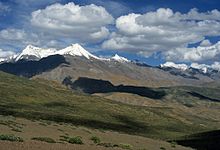
Back مناخ الهند Arabic ভাৰতৰ জলবায়ু Assamese भारत के जलवायु Bihari ভারতের জলবায়ু Bengali/Bangla Clima de la India Spanish Climat de l'Inde French Yanayi na Indiya Hausa भारत की जलवायु Hindi India éghajlata Hungarian Clima dell'India Italian


The climate of India consists of a wide range of weather conditions across a vast geographic scale and varied topography. Based on the Köppen system, India encompasses a diverse array of climatic subtypes. These range from arid and semi-arid regions in the west to highland, sub-arctic, tundra, and ice cap climates in the northern Himalayan regions, varying with elevation. The northern lowlands experience subtropical conditions, with some areas at higher altitudes, like Srinagar, touching continental climates. In contrast, much of the south and the east exhibit tropical climate conditions, which support lush rainforests in these territories. Many regions have starkly different microclimates, making it one of the most climatically diverse countries in the world. The country's meteorological department follows the international standard of four seasons with some local adjustments: winter (December to February), summer (March to May), monsoon or rainy season (June to September), and a post-monsoon period (October and November).
India's geography and geology are climatically pivotal: the Thar Desert in the northwest and the Himalayas in the north work in tandem to create a culturally and economically important monsoonal regime. As Earth's highest and most massive mountain range, the Himalayas bar the influx of frigid katabatic winds from the icy Tibetan Plateau and northerly Central Asia. Most of North India is thus kept warm or is only mildly chilly or cold during winter; the same thermal dam keeps most regions in India hot in summer. The climate in South India is generally warmer, and more humid due to its coastlines. However some hill stations in South India such as Ooty are well known for their cold climate.
Though the Tropic of Cancer—the boundary that is between the tropics and subtropics—passes through the middle of India, the bulk of the country can be regarded as climatically tropical. As in much of the tropics, monsoonal and other weather patterns in India can be strongly variable: epochal droughts, heat waves, floods, cyclones, and other natural disasters are sporadic, but have displaced or ended millions of human lives. Such climatic events are likely to change in frequency and severity as a consequence of human-induced climate change. Ongoing and future vegetative changes, sea level rise and inundation of India's low-lying coastal areas are also attributed to global warming.[2]
- ^ Rowley DB (1996). "Age of initiaotion of collision between India and Asia: A review of stratigraphic data" (PDF). Earth and Planetary Science Letters. 145 (1): 1–13. Bibcode:1996E&PSL.145....1R. doi:10.1016/s0012-821x(96)00201-4. Archived from the original (PDF) on 28 December 2006. Retrieved 31 March 2007.
- ^ Ravindranath, Bala & Sharma 2011.
© MMXXIII Rich X Search. We shall prevail. All rights reserved. Rich X Search